
In diesem Artikel wird hauptsächlich ein Beispiel für eine einfache Anmeldefunktion vorgestellt, die von struts1 implementiert wird (Quellcode im Anhang). Der Herausgeber findet es recht gut, daher werde ich es jetzt mit Ihnen teilen und als Referenz verwenden. Folgen wir dem Editor, um einen Blick darauf zu werfen
Umgebung: MyEclipse 14
1 Struts1-Framework-Konstruktion
Erstellen Sie ein neues Webprojekt in MyEclipse und benennen Sie es struts1_login. Zu diesem Zeitpunkt ist es ein leeres Dokument und ich werde keinen Screenshot machen. Klicken Sie dann mit der rechten Maustaste auf das Projekt und wählen Sie „Myeclipse“ aus und fügen Sie Struts-Funktionen hinzu 🎜>Klicken Sie auf „Apache Struts (1 Der Paketname, der sich auf Ihr Projekt beziehen soll. Mein Paketname lautet beispielsweise com.lichang.struts1
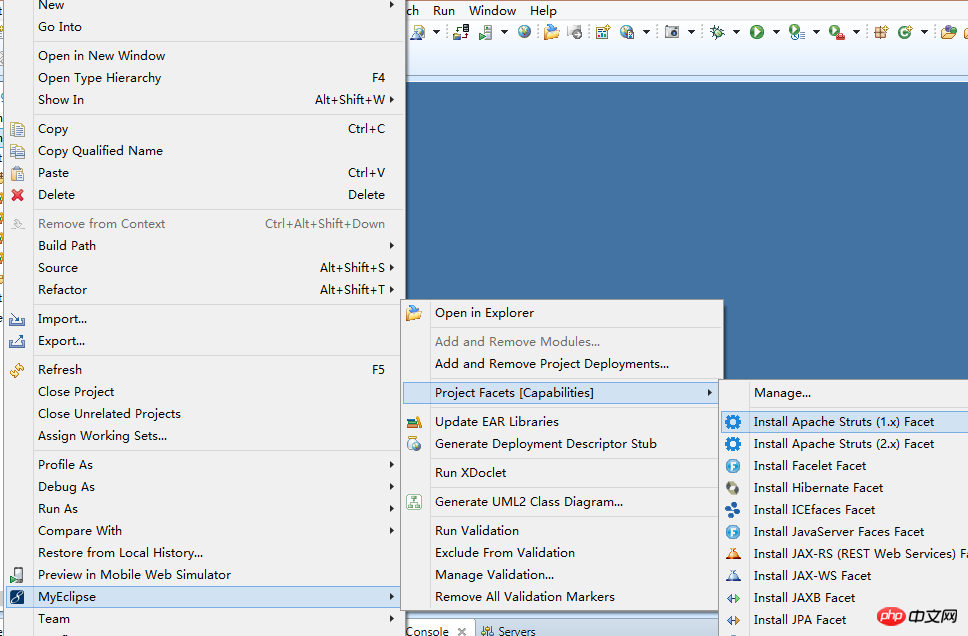
Klicken Sie auf „Weiter“
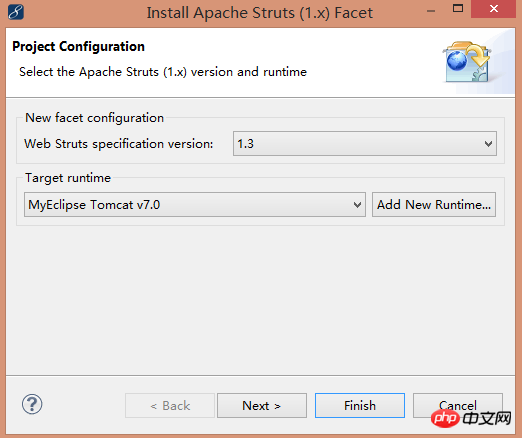
Klicken Sie zum Vervollständigen auf unserer WEBseite Unter -INF
wird es eine zusätzliche struts-config.xml-Datei geben. Das Obige ist der allgemeine Prozess, bei dem myeclipse uns beim Hinzufügen des Frameworks helfen kann. Die Gesamtstruktur des Projekts ist wie folgt: 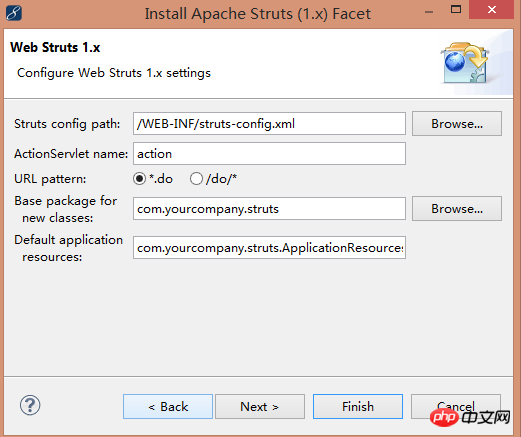
Zu diesem Zeitpunkt ist unser Struts1-Framework fertiggestellt 2 und dann beginnen wir mit der Programmierung, um es umzusetzen. 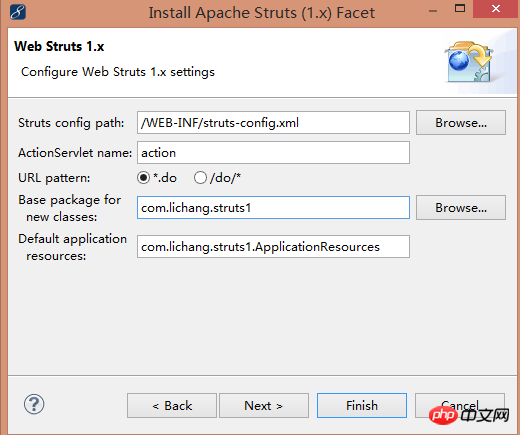
2 Dann begannen wir mit der Programmierung, um es umzusetzen.
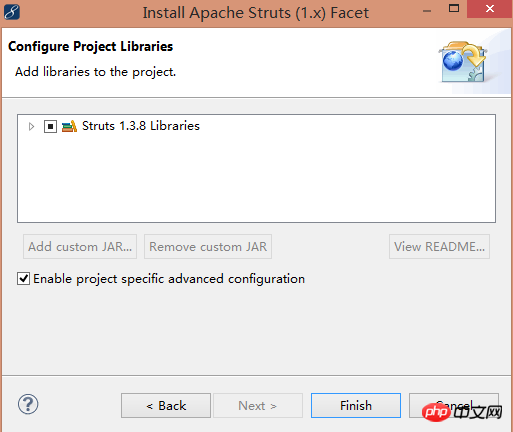 web.xml lautet wie folgt:
web.xml lautet wie folgt:
index.jsp-Code lautet wie folgt: 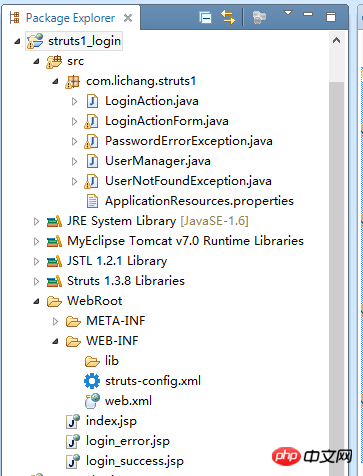
login_error.jsp-Code lautet wie folgt:
login_success.jsp-Code lautet wie folgt:
LoginAction.java-Code lautet wie folgt:
<?xml version="1.0" encoding="UTF-8"?> <web-app xmlns:xsi="http://www.w3.org/2001/XMLSchema-instance" xmlns="http://java.sun.com/xml/ns/javaee" xsi:schemaLocation="http://java.sun.com/xml/ns/javaee http://java.sun.com/xml/ns/javaee/web-app_3_0.xsd" id="WebApp_ID" version="3.0"> <display-name>struts1_login</display-name> <welcome-file-list> <welcome-file>index.html</welcome-file> <welcome-file>index.htm</welcome-file> <welcome-file>index.jsp</welcome-file> <welcome-file>default.html</welcome-file> <welcome-file>default.htm</welcome-file> <welcome-file>default.jsp</welcome-file> </welcome-file-list> <servlet> <servlet-name>action</servlet-name> <servlet-class>org.apache.struts.action.ActionServlet</servlet-class> <init-param> <param-name>config</param-name> <param-value>/WEB-INF/struts-config.xml</param-value> </init-param> <init-param> <param-name>debug</param-name> <param-value>3</param-value> </init-param> <init-param> <param-name>detail</param-name> <param-value>3</param-value> </init-param> <load-on-startup>0</load-on-startup> </servlet> <servlet-mapping> <servlet-name>action</servlet-name> <url-pattern>*.do</url-pattern> </servlet-mapping> </web-app>
LoginActionForm.java-Code lautet wie folgt:
<?xml version="1.0" encoding="UTF-8"?>
<!DOCTYPE struts-config PUBLIC "-//Apache Software Foundation//DTD Struts Configuration 1.3//EN" "http://struts.apache.org/dtds/struts-config_1_3.dtd">
<struts-config>
<form-beans>
<form-bean name="loginForm" type="com.lichang.struts1.LoginActionForm"/>
</form-beans>
<action-mappings>
<!-- path:指定访问时的路径 type:指定Action所在的类(一般是:包名.类名) name:指定和哪个表单(和jsp中Javabean
差不多的东西)对应,该例中name就和com.lichang.struts1.LoginActionForm类对应-->
<action path="/login"
type="com.lichang.struts1.LoginAction"
name="loginForm"
scope="request"
>
<forward name="success" path="/login_success.jsp" />
<forward name="error" path="/login_error.jsp"/>
</action>
</action-mappings>
<message-resources parameter="com.lichang.struts1.ApplicationResources" />
</struts-config>UserManager.java-Code lautet wie folgt:
<%@ page language="java" import="java.util.*" pageEncoding="UTF-8"%> <!DOCTYPE HTML PUBLIC "-//W3C//DTD HTML 4.01 Transitional//EN"> <html style="text-align:center"> <head style="text-align:center"> <title>index page</title> <meta http-equiv="pragma" content="no-cache"> <meta http-equiv="cache-control" content="no-cache"> <meta http-equiv="expires" content="0"> <!-- <link rel="stylesheet" type="text/css" href="styles.css" rel="external nofollow" rel="external nofollow" rel="external nofollow" > --> </head> <body style="text-align:center"> <form action="login.do" method="post"> 用户:<input type="text" name="username"><br> 密码:<input type="password" name="password"></br> <input type="submit" value="登录"> </form> </body> </html>
UserNotFoundException.java Der Code lautet wie folgt:
<%@ page language="java" import="java.util.*" pageEncoding="UTF-8"%>
<!DOCTYPE HTML PUBLIC "-//W3C//DTD HTML 4.01 Transitional//EN">
<html>
<head>
<title>error page</title>
<meta http-equiv="pragma" content="no-cache">
<meta http-equiv="cache-control" content="no-cache">
<meta http-equiv="expires" content="0">
<!--
<link rel="stylesheet" type="text/css" href="styles.css" rel="external nofollow" rel="external nofollow" rel="external nofollow" >
-->
</head>
<body>
<%--
<%=request.getAttribute("msg") %>
--%>
${msg }
</body>
</html>PasswordErrorException.java Der Code lautet wie folgt:
<%@ page language="java" import="java.util.*" pageEncoding="UTF-8"%>
<!DOCTYPE HTML PUBLIC "-//W3C//DTD HTML 4.01 Transitional//EN">
<html>
<head>
<title>success page</title>
<meta http-equiv="pragma" content="no-cache">
<meta http-equiv="cache-control" content="no-cache">
<meta http-equiv="expires" content="0">
<!--
<link rel="stylesheet" type="text/css" href="styles.css" rel="external nofollow" rel="external nofollow" rel="external nofollow" >
-->
</head>
<body>
${username },登录成功
</body>
</html>Screenshot des laufenden Teils
package com.lichang.struts1;
import javax.servlet.http.HttpServletRequest;
import javax.servlet.http.HttpServletResponse;
import org.apache.struts.action.Action;
import org.apache.struts.action.ActionForm;
import org.apache.struts.action.ActionForward;
import org.apache.struts.action.ActionMapping;
//这个类充当控制器
public class LoginAction extends Action {
public ActionForward execute(ActionMapping mapping, ActionForm form,
HttpServletRequest request, HttpServletResponse response)
throws Exception {
//从actionForm中获取username和password
LoginActionForm laf = (LoginActionForm)form;
String username = laf.getUsername();
String password = laf.getPassword();
//调用业务逻辑类
UserManager userManager = new UserManager();
try {
userManager.login(username, password);
return mapping.findForward("success");
}catch(UserNotFoundException e) {
e.printStackTrace();
request.setAttribute("msg", "用户不能找到,用户名称=" + username );
}catch(PasswordErrorException e) {
e.printStackTrace();
request.setAttribute("msg", "密码错误");
}
return mapping.findForward("error");
}
}package com.lichang.struts1;
import org.apache.struts.action.ActionForm;
/**
*
* ActionForm(表单用于获取用户输入的数据,相当于jsp中的Javabean)
* 不过sturts1在底层上实现了一些特别的方法以至于当Java程序员定义了Javabean并继承ActionForm并实现setXXX()方法时
* 用户表单中元素的值就被一一赋给我们自己定义的变量。如public void setUsername(String username)方法就可把form中username
* 赋给username变量
*
*/
public class LoginActionForm extends ActionForm {
private String username;
private String password;
public String getUsername() {
return username;
}
public void setUsername(String username) {
this.username = username;
}
public String getPassword() {
return password;
}
public void setPassword(String password) {
this.password = password;
}
}package com.lichang.struts1;
//这个类就是用来处理用户登录的业务逻辑
public class UserManager {
public void login(String username, String password) {
if (!"admin".equals(username)) {
throw new UserNotFoundException();
}
if (!"admin".equals(password)) {
throw new PasswordErrorException();
}
}
}package com.lichang.struts1;
public class UserNotFoundException extends RuntimeException {
public UserNotFoundException() {
// TODO Auto-generated constructor stub
}
public UserNotFoundException(String message) {
super(message);
// TODO Auto-generated constructor stub
}
public UserNotFoundException(Throwable cause) {
super(cause);
// TODO Auto-generated constructor stub
}
public UserNotFoundException(String message, Throwable cause) {
super(message, cause);
// TODO Auto-generated constructor stub
}
}Quellcode-Download-Adresse: struts1_login_jb51.rar
Das obige ist der detaillierte Inhalt vonCodebeispiel für struts1 zur Implementierung der Anmeldefunktion. Für weitere Informationen folgen Sie bitte anderen verwandten Artikeln auf der PHP chinesischen Website!




